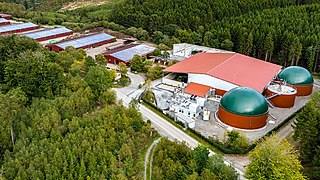
Anaerobic digestion is a sequence of processes by which microorganisms break down biodegradable material in the absence of oxygen. The process is used for industrial or domestic purposes to manage waste or to produce fuels. Much of the fermentation used industrially to produce food and drink products, as well as home fermentation, uses anaerobic digestion.

A biorefinery is a refinery that converts biomass to energy and other beneficial byproducts. The International Energy Agency Bioenergy Task 42 defined biorefining as "the sustainable processing of biomass into a spectrum of bio-based products and bioenergy ". As refineries, biorefineries can provide multiple chemicals by fractioning an initial raw material (biomass) into multiple intermediates that can be further converted into value-added products. Each refining phase is also referred to as a "cascading phase". The use of biomass as feedstock can provide a benefit by reducing the impacts on the environment, as lower pollutants emissions and reduction in the emissions of hazard products. In addition, biorefineries are intended to achieve the following goals:
- Supply the current fuels and chemical building blocks
- Supply new building blocks for the production of novel materials with disruptive characteristics
- Creation of new jobs, including rural areas
- Valorization of waste
- Achieve the ultimate goal of reducing GHG emissions
Bioconversion, also known as biotransformation, is the conversion of organic materials, such as plant or animal waste, into usable products or energy sources by biological processes or agents, such as certain microorganisms. One example is the industrial production of cortisone, which one step is the bioconversion of progesterone to 11-alpha-Hydroxyprogesterone by Rhizopus nigricans. Another example is the bioconversion of glycerol to 1,3-propanediol, which is part of scientific research for many decades.

The bioconversion of biomass to mixed alcohol fuels can be accomplished using the MixAlco process. Through bioconversion of biomass to a mixed alcohol fuel, more energy from the biomass will end up as liquid fuels than in converting biomass to ethanol by yeast fermentation.

Green waste, also known as "biological waste", is any organic waste that can be composted. It is most usually composed of refuse from gardens such as grass clippings or leaves, and domestic or industrial kitchen wastes. Green waste does not include things such as dried leaves, pine straw, or hay. Such materials are rich in carbon and considered "brown wastes," while green wastes contain high concentrations of nitrogen. Green waste can be used to increase the efficiency of many composting operations and can be added to soil to sustain local nutrient cycling.

Aerobic granular reactors (AGR) or Aerobic granular sludge (AGS) are a community of microbial organisms, typically around 0.5-3mm in diameter, that remove carbon, nitrogen, phosphorus and other pollutants in a single sludge system. It can also be used for wastewater treatments. Aerobic granular sludge is composed of bacteria, protozoa and fungi, which allows oxygen to follow in and biologically oxidize organic pollutants. AGS is a type of wastewater treatment process for sewages and/or industrial waste treatment. AGR was first discovered by UK engineers, Edward Ardern and W.T. Lockett who were researching better ways for sewage disposal. Another scientist by the name of Dr. Gilbert Fowler, who was at the University of Manchester working on an experiment based on aeration of sewage in a bottle coated with algae. Eventually, all three scientists were able to collaborate with one another to discover AGR/AGS.
Biodrying is the process by which biodegradable waste is rapidly heated through initial stages of composting to remove moisture from a waste stream and hence reduce its overall weight. In biodrying processes, the drying rates are augmented by biological heat in addition to forced aeration. The major portion of biological heat, naturally available through the aerobic degradation of organic matter, is utilized to evaporate surface and bound water associated with the mixed sludge. This heat generation assists in reducing the moisture content of the biomass without the need for supplementary fossil fuels, and with minimal electricity consumption. It can take as little as 8 days to dry waste in this manner. This enables reduced costs of disposal if landfill is charged on a cost per tonne basis. Biodrying may be used as part of the production process for refuse-derived fuels. Biodrying does not however greatly affect the biodegradability of the waste and hence is not stabilised. Biodried waste will still break down in a landfill to produce landfill gas and hence potentially contribute to climate change. In the UK this waste will still impact upon councils LATS allowances. Whilst biodrying is increasingly applied within commercial mechanical biological treatment (MBT) plants, it is also still subject to on-going research and development.

Methanobacteria is a class of archaeans in the kingdom Euryarchaeota. Several of the classes of the Euryarchaeota are methanogens and the Methanobacteria are one of these classes.
The Department of Biotechnology (DBT) is an Indian government department, under the Ministry of Science and Technology responsible for administrating development and commercialisation in the field of modern biology and biotechnology in India. It was set up in 1986.

Hainan University is a provincial public university in Haikou, Hainan, China. It is affiliated with the Province of Hainan, and co-funded by the Hainan Provincial People's Government, the Ministry of Education, and the Ministry of Finance. The university is part of Project 211 and the Double First-Class Construction.

Agricultural engineering, also known as agricultural and biosystems engineering, is the field of study and application of engineering science and designs principles for agriculture purposes, combining the various disciplines of mechanical, civil, electrical, food science, environmental, software, and chemical engineering to improve the efficiency of farms and agribusiness enterprises as well as to ensure sustainability of natural and renewable resources.
The Faculty of Agriculture of Kagawa University specializes in pure and applied research in bioscience and biotechnology.

The Journal of Chemical Technology & Biotechnology is a monthly peer-reviewed scientific journal. It was established in 1882 as the Journal of the Society of Chemical Industry by the Society of Chemical Industry (SCI). In 1950 it changed its title to Journal of Applied Chemistry and volume numbering restarted at 1. In 1971 the journal changed its title to Journal of Applied Chemistry and Biotechnology and in 1983 it obtained the current title. It covers chemical and biological technology relevant for economically and environmentally sustainable industrial processes. The journal is published by John Wiley & Sons on behalf of SCI.
Agricultural wastes may refer to:
Bioproducts or bio-based products are materials, chemicals and energy derived from renewable biological material.
Bioresource engineering is similar to biological engineering, except that it is based on biological and/or agricultural feedstocks. Bioresource engineering is more general and encompasses a wider range of technologies and various elements such as biomass, biological waste treatment, bioenergy, biotransformations, bioresource systems analysis, bioremediation and technologies associated with Thermochemical conversion technologies such as combustion, pyrolysis, gasification, catalysis, etc.
Agricultural microbiology is a branch of microbiology dealing with plant-associated microbes and plant and animal diseases. It also deals with the microbiology of soil fertility, such as microbial degradation of organic matter and soil nutrient transformations. The primary goal of agricultural microbiology is to comprehensively explore the interactions between beneficial microorganisms like bacteria and fungi with crops. It also deals with the microbiology of soil fertility, such as microbial degradation of organic matter and soil nutrient transformations.
V. K. Garg is dean of the School of Environment And Earth Sciences, Central University Of Punjab, Bathinda. He is also dean of students welfare of CUPB. He visited EPFL, Lausanne, Switzerland, in 2015 as visiting scientist, Deakin University, Geelong, Australia, in January–February 2014 under TEQIP-II Programme.








